Overview
- Description
- Collection of documents, memoirs, and photographs relating to Ingeborg De Vries [donor's mother] and Abigail De Vries [donor's grandmother] as well as their friends Simon Berklou and others who survived the Holocaust in Holland and Theresienstadt. The collection includes identification cards issued by the Jewish Council of Amsterdam, permits, and orders.
- Credit Line
- United States Holocaust Memorial Museum Collection, Gift of Diana Nikkels
Physical Details
- Extent
-
2 boxes
1 oversize folder
Rights & Restrictions
- Conditions on Access
- There are no known restrictions on access to this material.
- Conditions on Use
- The donor, source institution, or a third party has asserted copyright over some or all of these material(s). The Museum does not own the copyright for the material and does not have authority to authorize use. For permission, please contact the rights holder(s).
Keywords & Subjects
- Geographic Name
- Netherlands.
- Corporate Name
- Theresienstadt (Concentration camp)
Administrative Notes
- Holder of Originals
-
United States Holocaust Memorial Museum
- Legal Status
- Permanent Collection
- Provenance
- Donated to the United States Holocaust Memorial Museum in 2009 by Diana Nikkels
- Record last modified:
- 2022-07-28 17:50:05
- This page:
- https://collections.ushmm.org/search/catalog/irn38947
Download & Licensing
- In Copyright
- Terms of Use
- This record is digitized but cannot be downloaded online.
In-Person Research
- Requires Research Visit
- Plan a Research Visit
-
Request in Shapell Center Reading Room
Bowie, MD
Contact Us
Also in Abigael de Vries family collection
The collection consists of artifacts, documents, and photographs relating to the experiences of Abigael de Vries, Ingeborg de Vries Nikkels, Simon Berklou, and friends in the Netherlands during World War II.
Date: 1940-1947
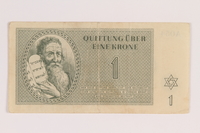
Theresienstadt ghetto-labor camp scrip, 1 krone note, issued to a Dutch Jewish inmate
Object
Scrip, valued at 1 krone, that may have been issued to Abigael de Vries in the Theresienstadt (Terezin) ghetto-labor camp in 1943. All currency was confiscated from deportees upon entry and replaced with scrip and ration coupons that could be exchanged only in the camp. Abigael was living in Amsterdam with her two children, 10 year old Hansje and 9 year old Ingeborg, when it was occupied by Germany in May 1940. The family was deported to Westerbork transit camp on May 26, 1943. In September, the children were released and sent to an orphanage in Amsterdam. Abigael was deported the next day to Bergen-Belsen concentration camp. On January 25, 1944, she was transferred to Theresienstadt and was there when the camp was liberated by Soviet troops on May 9, 1945. She was able to return to Amsterdam in July 1945. Her children were with her sisters who had taken custody of them from the orphanage in 1943. Hansje was paralyzed from the neck down, having been shot in the neck by a German soldier on April 23, 1945, while foraging for coal with his sister. Amsterdam had experienced severe food and fuel emergencies since the spring of 1945 so Abigael sent Inge to Copenhagen. Hansje died of his injuries on July 11, 1946.
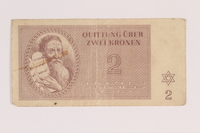
Theresienstadt ghetto-labor camp scrip, 2 kronen note, issued to a Dutch Jewish inmate
Object
Scrip, valued at 2 kronen, that may have been issued to Abigael de Vries in the Theresienstadt (Terezin) ghetto-labor camp in 1943. All currency was confiscated from deportees upon entry and replaced with scrip and ration coupons that could be exchanged only in the camp. Abigael was living in Amsterdam with her two children, 10 year old Hansje and 9 year old Ingeborg, when it was occupied by Germany in May 1940. The family was deported to Westerbork transit camp on May 26, 1943. In September, the children were released and sent to an orphanage in Amsterdam. Abigael was deported the next day to Bergen-Belsen concentration camp. On January 25, 1944, she was transferred to Theresienstadt and was there when the camp was liberated by Soviet troops on May 9, 1945. She was able to return to Amsterdam in July 1945. Her children were with her sisters who had taken custody of them from the orphanage in 1943. Hansje was paralyzed from the neck down, having been shot in the neck by a German soldier on April 23, 1945, while foraging for coal with his sister. Amsterdam had experienced severe food and fuel emergencies since the spring of 1945 so Abigael sent Inge to Copenhagen. Hansje died of his injuries on July 11, 1946.
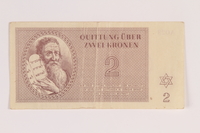
Theresienstadt ghetto-labor camp scrip, 2 kronen note, issued to a Dutch Jewish inmate
Object
Scrip, valued at 2 kronen, that may have been issued to Abigael de Vries in the Theresienstadt (Terezin) ghetto-labor camp in 1943. All currency was confiscated from deportees upon entry and replaced with scrip and ration coupons that could be exchanged only in the camp. Abigael was living in Amsterdam with her two children, 10 year old Hansje and 9 year old Ingeborg, when it was occupied by Germany in May 1940. The family was deported to Westerbork transit camp on May 26, 1943. In September, the children were released and sent to an orphanage in Amsterdam. Abigael was deported the next day to Bergen-Belsen concentration camp. On January 25, 1944, she was transferred to Theresienstadt and was there when the camp was liberated by Soviet troops on May 9, 1945. She was able to return to Amsterdam in July 1945. Her children were with her sisters who had taken custody of them from the orphanage in 1943. Hansje was paralyzed from the neck down, having been shot in the neck by a German soldier on April 23, 1945, while foraging for coal with his sister. Amsterdam had experienced severe food and fuel emergencies since the spring of 1945 so Abigael sent Inge to Copenhagen. Hansje died of his injuries on July 11, 1946.
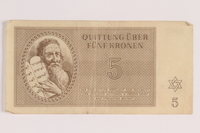
Theresienstadt ghetto-labor camp scrip, 5 kronen note, issued to a Dutch Jewish inmate
Object
Scrip, valued at 5 kronen, that may have been issued to Abigael de Vries in the Theresienstadt (Terezin) ghetto-labor camp in 1943. All currency was confiscated from deportees upon entry and replaced with scrip and ration coupons that could be exchanged only in the camp. Abigael was living in Amsterdam with her two children, 10 year old Hansje and 9 year old Ingeborg, when it was occupied by Germany in May 1940. The family was deported to Westerbork transit camp on May 26, 1943. In September, the children were released and sent to an orphanage in Amsterdam. Abigael was deported the next day to Bergen-Belsen concentration camp. On January 25, 1944, she was transferred to Theresienstadt and was there when the camp was liberated by Soviet troops on May 9, 1945. She was able to return to Amsterdam in July 1945. Her children were with her sisters who had taken custody of them from the orphanage in 1943. Hansje was paralyzed from the neck down, having been shot in the neck by a German soldier on April 23, 1945, while foraging for coal with his sister. Amsterdam had experienced severe food and fuel emergencies since the spring of 1945 so Abigael sent Inge to Copenhagen. Hansje died of his injuries on July 11, 1946.
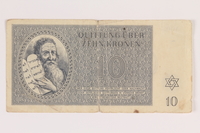
Theresienstadt ghetto-labor camp scrip, 10 kronen note, issued to a Dutch Jewish inmate
Object
Scrip, valued at 10 kronen, that may have been issued to Abigael de Vries in the Theresienstadt (Terezin) ghetto-labor camp in 1943. All currency was confiscated from deportees upon entry and replaced with scrip and ration coupons that could be exchanged only in the camp. Abigael was living in Amsterdam with her two children, 10 year old Hansje and 9 year old Ingeborg, when it was occupied by Germany in May 1940. The family was deported to Westerbork transit camp on May 26, 1943. In September, the children were released and sent to an orphanage in Amsterdam. Abigael was deported the next day to Bergen-Belsen concentration camp. On January 25, 1944, she was transferred to Theresienstadt and was there when the camp was liberated by Soviet troops on May 9, 1945. She was able to return to Amsterdam in July 1945. Her children were with her sisters who had taken custody of them from the orphanage in 1943. Hansje was paralyzed from the neck down, having been shot in the neck by a German soldier on April 23, 1945, while foraging for coal with his sister. Amsterdam had experienced severe food and fuel emergencies since the spring of 1945 so Abigael sent Inge to Copenhagen. Hansje died of his injuries on July 11, 1946.
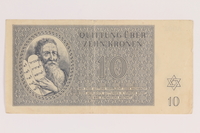
Theresienstadt ghetto-labor camp scrip, 10 kronen note, issued to a Dutch Jewish inmate
Object
Scrip, valued at 10 kronen, that may have been issued to Abigael de Vries in the Theresienstadt (Terezin) ghetto-labor camp in 1943. All currency was confiscated from deportees upon entry and replaced with scrip and ration coupons that could be exchanged only in the camp. Abigael was living in Amsterdam with her two children, 10 year old Hansje and 9 year old Ingeborg, when it was occupied by Germany in May 1940. The family was deported to Westerbork transit camp on May 26, 1943. In September, the children were released and sent to an orphanage in Amsterdam. Abigael was deported the next day to Bergen-Belsen concentration camp. On January 25, 1944, she was transferred to Theresienstadt and was there when the camp was liberated by Soviet troops on May 9, 1945. She was able to return to Amsterdam in July 1945. Her children were with her sisters who had taken custody of them from the orphanage in 1943. Hansje was paralyzed from the neck down, having been shot in the neck by a German soldier on April 23, 1945, while foraging for coal with his sister. Amsterdam had experienced severe food and fuel emergencies since the spring of 1945 so Abigael sent Inge to Copenhagen. Hansje died of his injuries on July 11, 1946.
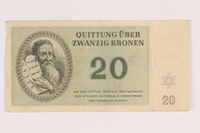
Theresienstadt ghetto-labor camp scrip, 20 kronen note, issued to a Dutch Jewish inmate
Object
Scrip, valued at 20 kronen, that may have been issued to Abigael de Vries in the Theresienstadt (Terezin) ghetto-labor camp in 1943. All currency was confiscated from deportees upon entry and replaced with scrip and ration coupons that could be exchanged only in the camp. Abigael was living in Amsterdam with her two children, 10 year old Hansje and 9 year old Ingeborg, when it was occupied by Germany in May 1940. The family was deported to Westerbork transit camp on May 26, 1943. In September, the children were released and sent to an orphanage in Amsterdam. Abigael was deported the next day to Bergen-Belsen concentration camp. On January 25, 1944, she was transferred to Theresienstadt and was there when the camp was liberated by Soviet troops on May 9, 1945. She was able to return to Amsterdam in July 1945. Her children were with her sisters who had taken custody of them from the orphanage in 1943. Hansje was paralyzed from the neck down, having been shot in the neck by a German soldier on April 23, 1945, while foraging for coal with his sister. Amsterdam had experienced severe food and fuel emergencies since the spring of 1945 so Abigael sent Inge to Copenhagen. Hansje died of his injuries on July 11, 1946.
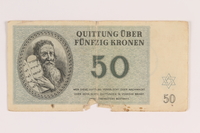
Theresienstadt ghetto-labor camp scrip, 50 kronen note, issued to a Dutch Jewish inmate
Object
Scrip, valued at 50 kronen, that may have been issued to Abigael de Vries in the Theresienstadt (Terezin) ghetto-labor camp in 1943. All currency was confiscated from deportees upon entry and replaced with scrip and ration coupons that could be exchanged only in the camp. Abigael was living in Amsterdam with her two children, 10 year old Hansje and 9 year old Ingeborg, when it was occupied by Germany in May 1940. The family was deported to Westerbork transit camp on May 26, 1943. In September, the children were released and sent to an orphanage in Amsterdam. Abigael was deported the next day to Bergen-Belsen concentration camp. On January 25, 1944, she was transferred to Theresienstadt and was there when the camp was liberated by Soviet troops on May 9, 1945. She was able to return to Amsterdam in July 1945. Her children were with her sisters who had taken custody of them from the orphanage in 1943. Hansje was paralyzed from the neck down, having been shot in the neck by a German soldier on April 23, 1945, while foraging for coal with his sister. Amsterdam had experienced severe food and fuel emergencies since the spring of 1945 so Abigael sent Inge to Copenhagen. Hansje died of his injuries on July 11, 1946.
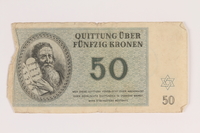
Theresienstadt ghetto-labor camp scrip, 50 kronen note, issued to a Dutch Jewish inmate
Object
Scrip, valued at 50 kronen, that may have been issued to Abigael de Vries in the Theresienstadt (Terezin) ghetto-labor camp in 1943. All currency was confiscated from deportees upon entry and replaced with scrip and ration coupons that could be exchanged only in the camp. Abigael was living in Amsterdam with her two children, 10 year old Hansje and 9 year old Ingeborg, when it was occupied by Germany in May 1940. The family was deported to Westerbork transit camp on May 26, 1943. In September, the children were released and sent to an orphanage in Amsterdam. Abigael was deported the next day to Bergen-Belsen concentration camp. On January 25, 1944, she was transferred to Theresienstadt and was there when the camp was liberated by Soviet troops on May 9, 1945. She was able to return to Amsterdam in July 1945. Her children were with her sisters who had taken custody of them from the orphanage in 1943. Hansje was paralyzed from the neck down, having been shot in the neck by a German soldier on April 23, 1945, while foraging for coal with his sister. Amsterdam had experienced severe food and fuel emergencies since the spring of 1945 so Abigael sent Inge to Copenhagen. Hansje died of his injuries on July 11, 1946.

Theresienstadt ghetto-labor camp scrip, 100 kronen note, issued to a Dutch Jewish inmate
Object
Scrip, valued at 100 kronen, that may have been issued to Abigael de Vries in the Theresienstadt (Terezin) ghetto-labor camp in 1943. All currency was confiscated from deportees upon entry and replaced with scrip and ration coupons that could be exchanged only in the camp. Abigael was living in Amsterdam with her two children, 10 year old Hansje and 9 year old Ingeborg, when it was occupied by Germany in May 1940. The family was deported to Westerbork transit camp on May 26, 1943. In September, the children were released and sent to an orphanage in Amsterdam. Abigael was deported the next day to Bergen-Belsen concentration camp. On January 25, 1944, she was transferred to Theresienstadt and was there when the camp was liberated by Soviet troops on May 9, 1945. She was able to return to Amsterdam in July 1945. Her children were with her sisters who had taken custody of them from the orphanage in 1943. Hansje was paralyzed from the neck down, having been shot in the neck by a German soldier on April 23, 1945, while foraging for coal with his sister. Amsterdam had experienced severe food and fuel emergencies since the spring of 1945 so Abigael sent Inge to Copenhagen. Hansje died of his injuries on July 11, 1946.
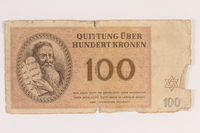
Theresienstadt ghetto-labor camp scrip, 100 kronen note, issued to a Dutch Jewish inmate
Object
Scrip, valued at 100 kronen, that may have been issued to Abigael de Vries in the Theresienstadt (Terezin) ghetto-labor camp in 1943. All currency was confiscated from deportees upon entry and replaced with scrip and ration coupons that could be exchanged only in the camp. Abigael was living in Amsterdam with her two children, 10 year old Hansje and 9 year old Ingeborg, when it was occupied by Germany in May 1940. The family was deported to Westerbork transit camp on May 26, 1943. In September, the children were released and sent to an orphanage in Amsterdam. Abigael was deported the next day to Bergen-Belsen concentration camp. On January 25, 1944, she was transferred to Theresienstadt and was there when the camp was liberated by Soviet troops on May 9, 1945. She was able to return to Amsterdam in July 1945. Her children were with her sisters who had taken custody of them from the orphanage in 1943. Hansje was paralyzed from the neck down, having been shot in the neck by a German soldier on April 23, 1945, while foraging for coal with his sister. Amsterdam had experienced severe food and fuel emergencies since the spring of 1945 so Abigael sent Inge to Copenhagen. Hansje died of his injuries on July 11, 1946.
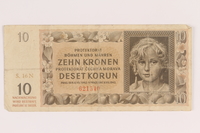
German occupation currency note, 10 kronen, issued in the Protectorate of Bohemia and Moravia
Object
Occupation currency note, valued at 20 kronen, issued in the Protectorate of Bohemia and Moravia in 1942. The Germans occupied these Czech provinces from 1939-1945, and created the Protectorate of Bohemia and Moravia as part of the Greater German Reich. The Czech garrison town of Theresienstadt (Terezin) was located within the Protectorate near the extended German border.
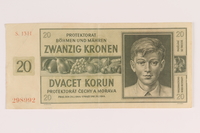
German occupation currency note, 20 kronen, issued in the Protectorate of Bohemia and Moravia
Object
Occupation currency note, valued at 20 kronen, issued in the Protectorate of Bohemia and Moravia in 1942. The Germans occupied these Czech provinces in 1939, and created the Protectorate of Bohemia and Moravia as part of the Greater German Reich. The Czech garrison town of Theresienstadt (Terezin) was located within the Protectorate near the extended German border.
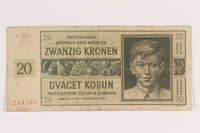
German occupation currency note, 20 kronen, issued in the Protectorate of Bohemia and Moravia
Object
Occupation currency note, valued at 20 kronen, issued in the Protectorate of Bohemia and Moravia in 1942. The Germans occupied these Czech provinces in 1939, and created the Protectorate of Bohemia and Moravia as part of the Greater German Reich. The Czech garrison town of Theresienstadt (Terezin) was located within the Protectorate near the extended German border.
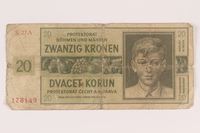
German occupation currency note, 20 kronen, issued in the Protectorate of Bohemia and Moravia
Object
Occupation currency note, valued at 20 kronen, issued in the Protectorate of Bohemia and Moravia in 1942. The Germans occupied these Czech provinces in 1939, and created the Protectorate of Bohemia and Moravia as part of the Greater German Reich. The Czech garrison town of Theresienstadt (Terezin) was located within the Protectorate near the extended German border.
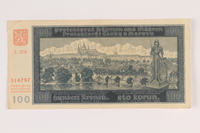
German occupation currency note, 100 kronen, issued in the Protectorate of Bohemia and Moravia
Object
Occupation currency note, valued at 100 kronen, issued in the Protectorate of Bohemia and Moravia in 1942. The Germans occupied these Czech provinces in 1939, and created the Protectorate of Bohemia and Moravia as part of the Greater German Reich. The Czech garrison town of Theresienstadt (Terezin) was located within the Protectorate near the extended German border.
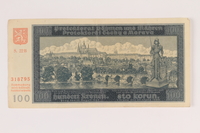
German occupation currency note, 100 kronen, issued in the Protectorate of Bohemia and Moravia
Object
Occupation currency note, valued at 100 kronen, issued in the Protectorate of Bohemia and Moravia in 1940. The Germans occupied these Czech provinces in 1939, and created the Protectorate of Bohemia and Moravia as part of the Greater German Reich. The Czech garrison town of Theresienstadt (Terezin) was located within the Protectorate near the extended German border.
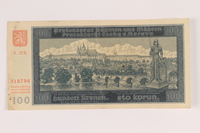
German occupation currency note, 100 kronen, issued in the Protectorate of Bohemia and Moravia
Object
Occupation currency note, valued at 100 kronen, issued in the Protectorate of Bohemia and Moravia in 1942. The Germans occupied these Czech provinces in 1939, and created the Protectorate of Bohemia and Moravia as part of the Greater German Reich. The Czech garrison town of Theresienstadt (Terezin) was located within the Protectorate near the extended German border.
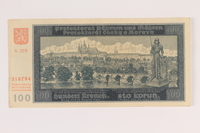
German occupation currency note, 100 kronen, issued in the Protectorate of Bohemia and Moravia
Object
Occupation currency note, valued at 100 kronen, issued in the Protectorate of Bohemia and Moravia in 1940. The Germans occupied these Czech provinces in 1939, and created the Protectorate of Bohemia and Moravia as part of the Greater German Reich. The Czech garrison town of Theresienstadt (Terezin) was located within the Protectorate near the extended German border.
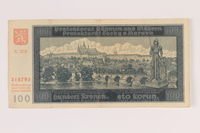
Protectorate of Bohemia and Moravia, 100 kronen note, issued in German occupied Czechosloavakia
Object
Occupation currency note, valued at 100 kronen, issued in the Protectorate of Bohemia and Moravia in 1940. Germany occupied these Czech provinces in March 1939, and created the Protectorate of Bohemia and Moravia as part of the Greater German Reich. The Czech garrison town of Theresienstadt (Terezin) was located within the Protectorate near the extended German border.
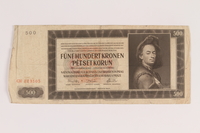
German occupation currency note, 500 kronen, issued in the Protectorate of Bohemia and Moravia
Object
Occupation currency note, valued at 500 kronen, issued in the Protectorate of Bohemia and Moravia in 1942. The Germans occupied these Czech provinces in 1939, and created the Protectorate of Bohemia and Moravia as part of the Greater German Reich. The Czech garrison town of Theresienstadt (Terezin) was located within the Protectorate near the extended German border.
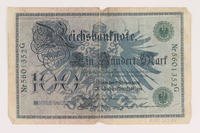
Imperial Germany Reichsbanknote, 100 marks, 100 marks, issued in 1908
Object
100 mark bank note issued in Imperial Germany in 1908. This note has a green seal which indicates it was printed post World War I (1914-1918.)
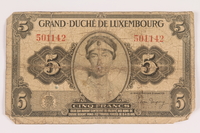
Luxembourg currency note, 5 francs, issued during the war
Object
5 franc bank note in use in 1944 in the Grand Duchy of Luxembourg.
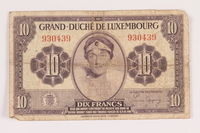
Luxembourg currency note, 10 francs, issued during the war
Object
10 franc bank note in use in 1944 in the Grand Duchy of Luxembourg.
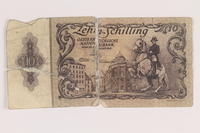
Austria paper currency note, 10 schillings, issued postwar
Object
10 schillings bank note issued by the Oesterreichische Nationalbank, Austria, in 1950.
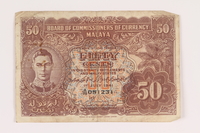
Straits Settlements and Malay States paper currency note, 50 cents, issued during World War II
Object
50 cents bank note issued in the Straits Settlements and Malay States in 1941. These settlements were colonies of Great Britain from 1867-1946. Beginning in 1939, the Malay dollar was recognized as leqal tender.
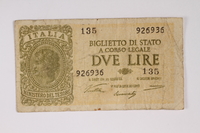
Italy currency note, 2 lire, issued by the Fascist government
Object
2 lire bank note issued in Italy from 1935-1944 when it was ruled by the Fascist government of Benito Mussolini.
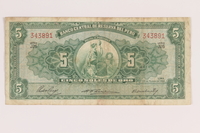
Peru currency note, 5 soles de oro, issued postwar
Object
5 soles de oro bank note issued by the Banco Central de Reserva del Perú in Peru in 1956.
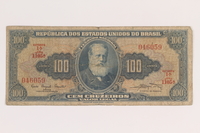
Brazil currency note, 100 cruzeiros, issued postwar
Object
100 cruzeiros bank note issued in Brazil.
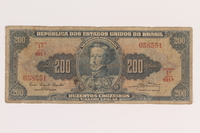
Brazil currency note, 200 cruzeiros, issued postwar.
Object
200 cruzeiros bank note issued in Brazil.
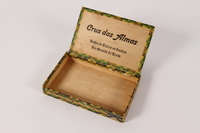
Brazilian cigar box
Object
Cigar box use to hold ration stamps that may have belonged to Abigail de Vries or her children. It is for a Brazilian cigar brand, but has a Dutch label on the bottom. Abigael was living in Amsterdam with her two children, 10 year old Hansje and 9 year old Ingeborg, when it was occupied by Germany in May 1940. The family was deported to Westerbork transit camp on May 26, 1943. In September, the children were released and sent to an orphanage in Amsterdam. Abigael was deported the next day to Bergen-Belsen concentration camp. On January 25, 1944, she was transferred to Theresienstadt which was liberated by Soviet troops on May 9, 1945. She was able to return to Amsterdam in July 1945. Her children were with her sisters who had taken custody of them from the orphanage in 1943. Hansje was paralyzed from the neck down, having been shot in the neck by a German soldier on April 23, 1945, while foraging for coal with his sister. Amsterdam had experienced severe food and fuel emergencies since the spring of 1945 so Abigael sent Inge to Copenhagen for several months to regain her health. Hansje died of his injuries on July 11, 1946.
Star of David badge with Jood for Jew worn by a Dutch Jewish woman
Object
Star of David badge issued to Abigael de Vries in the Netherlands in 1942-1943. Abigael was living in Amsterdam with her two children, 10 year old Hansje and 9 year old Ingeborg, when it was occupied by Germany in May 1940. The family was deported to Westerbork transit camp on May 26, 1943. In September, the children were released and sent to an orphanage in Amsterdam. Abigael was deported the next day to Bergen-Belsen concentration camp. On January 25, 1944, she was transferred to Theresienstadt which was liberated by Soviet troops on May 9, 1945. She was able to return to Amsterdam in July 1945. Her children were with her sisters who had taken custody of them from the orphanage in 1943. Hansje was paralyzed from the neck down, having been shot in the neck by a German soldier on April 23, 1945, while foraging for coal with his sister. Amsterdam had experienced severe food and fuel emergencies since the spring of 1945 so Abigael sent Inge to Copenhagen for several months to regain her health. Hansje died of his injuries on July 11, 1946.



